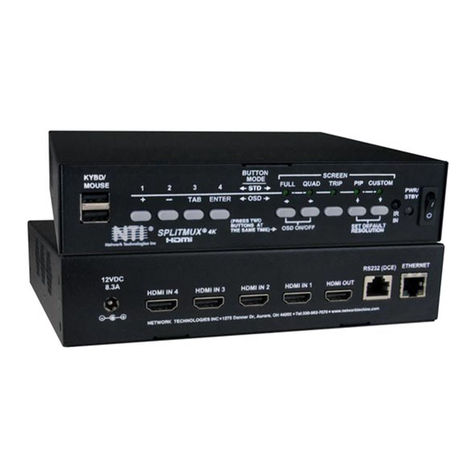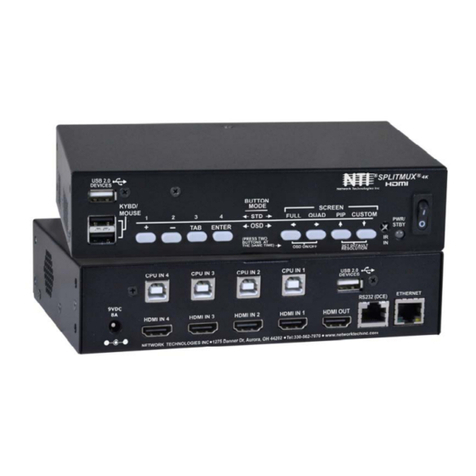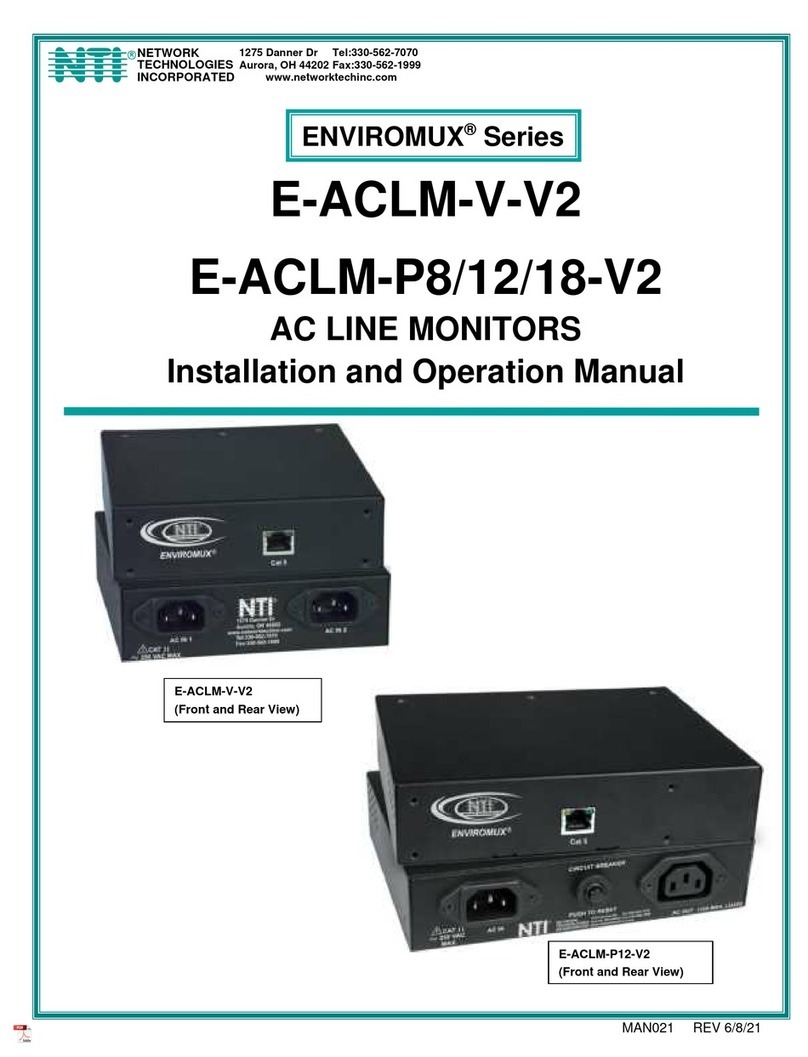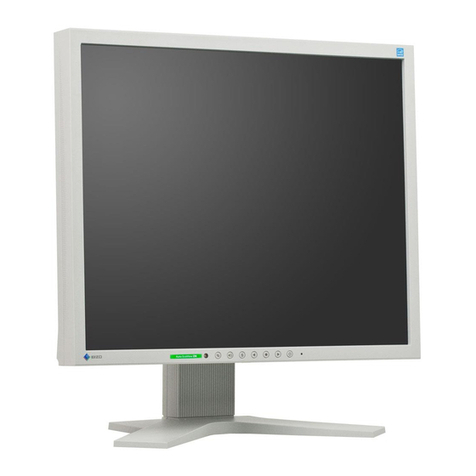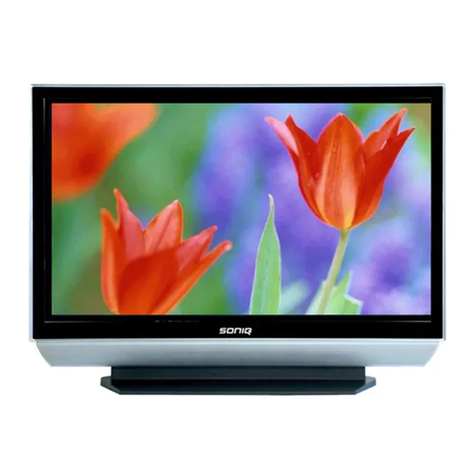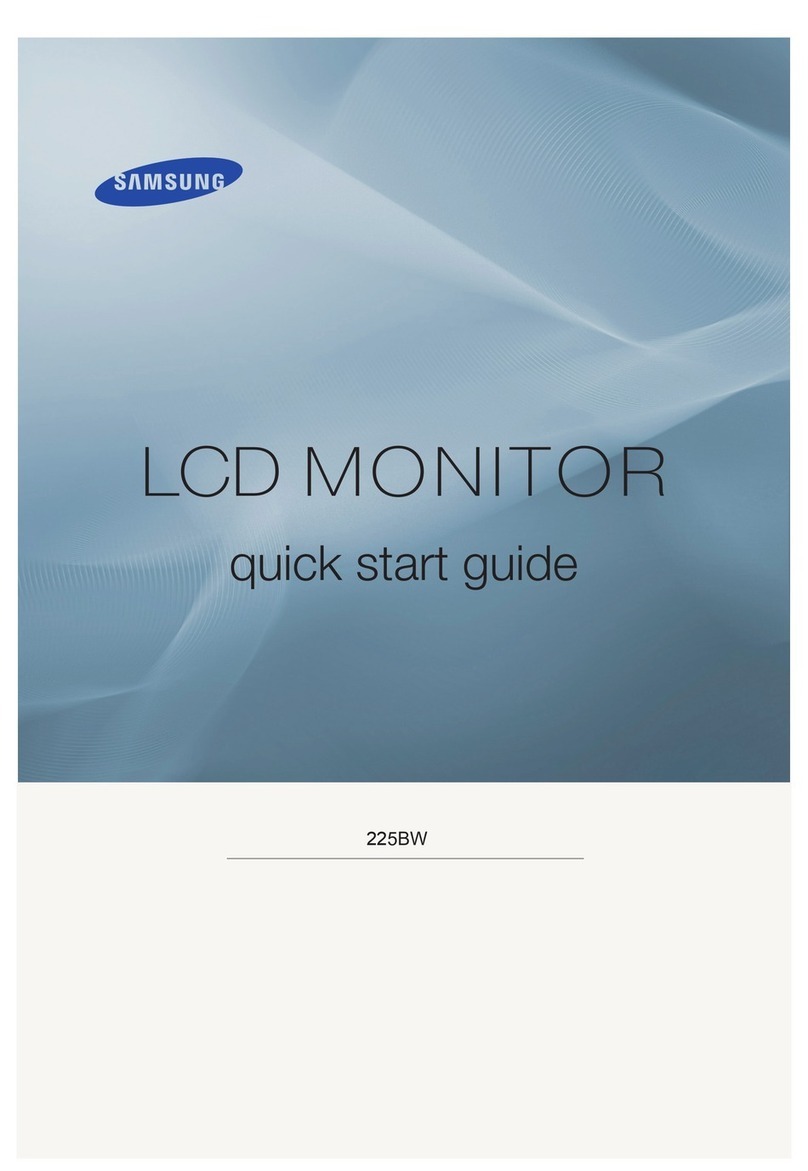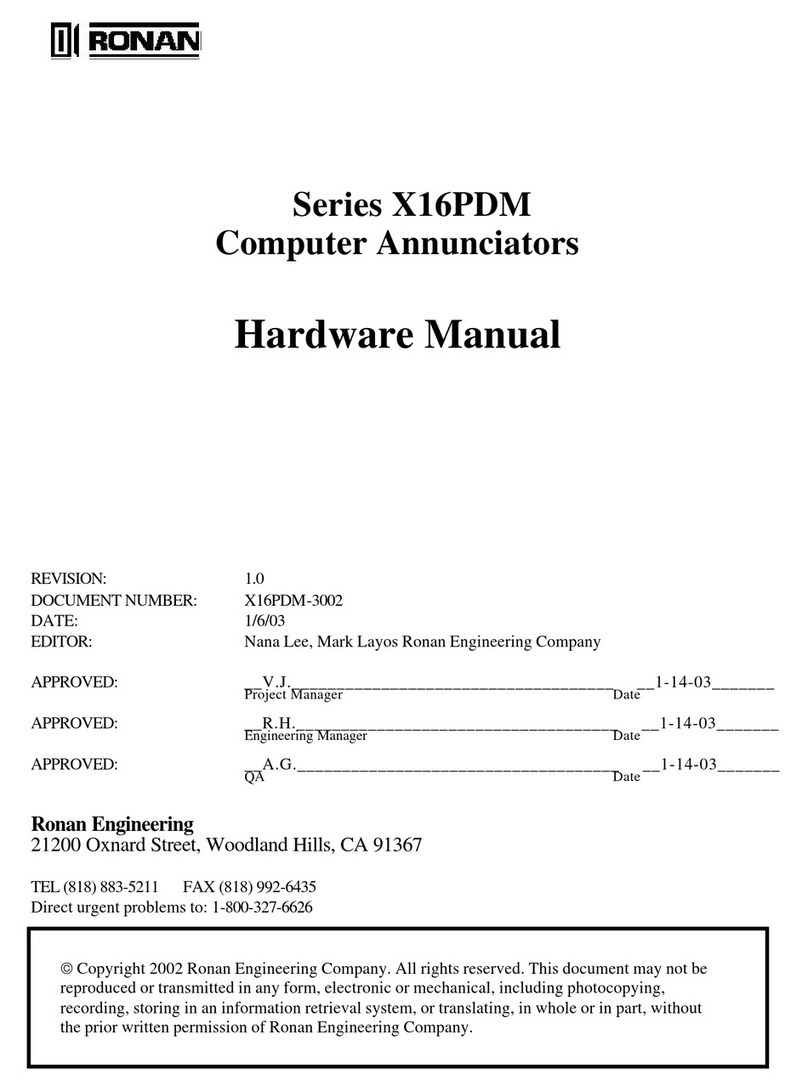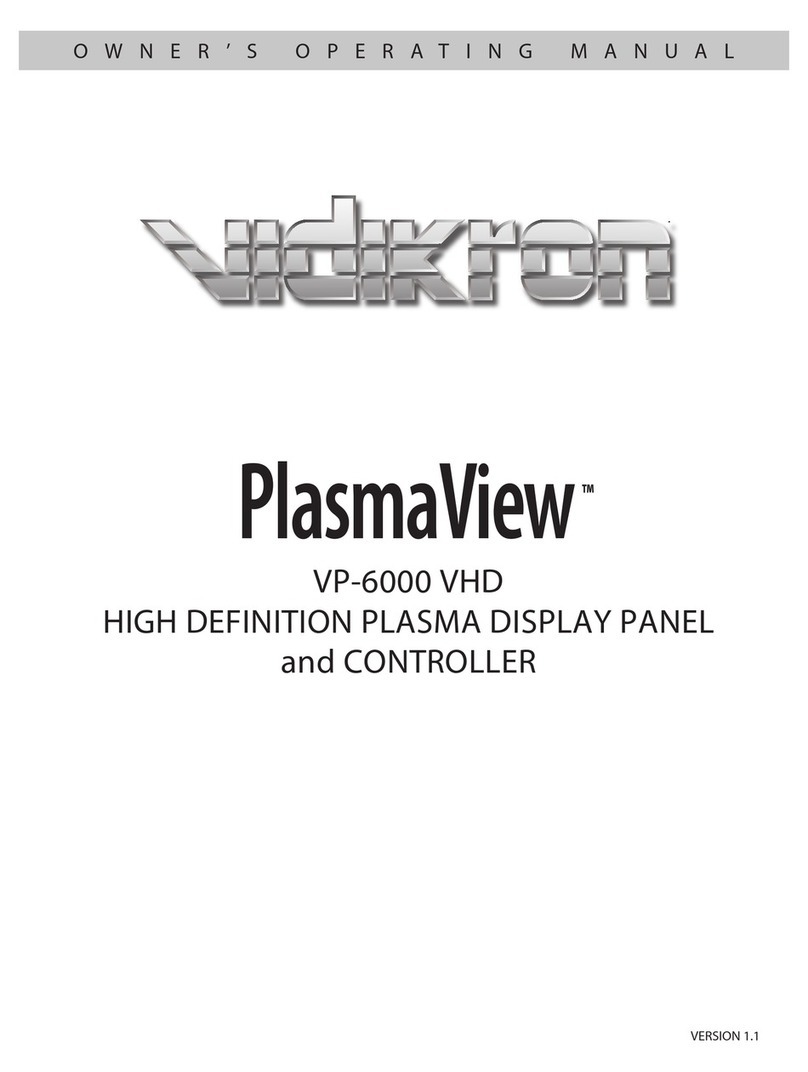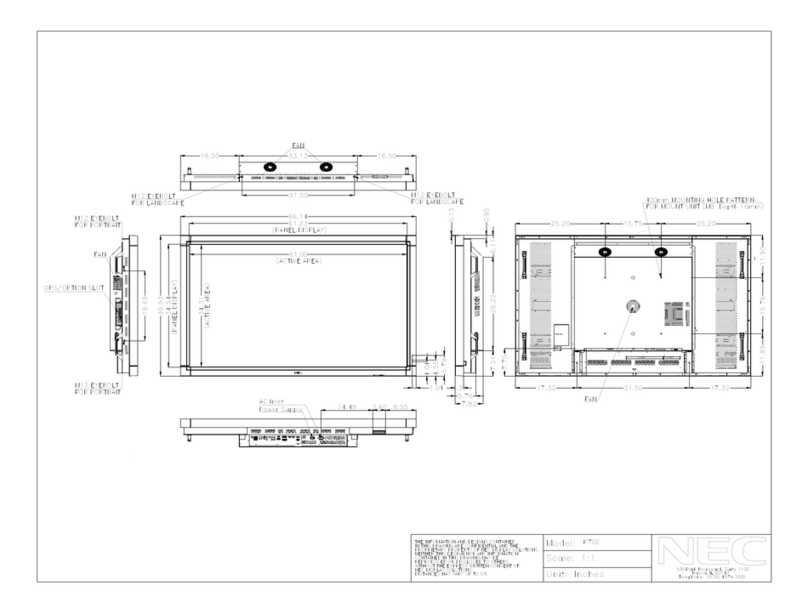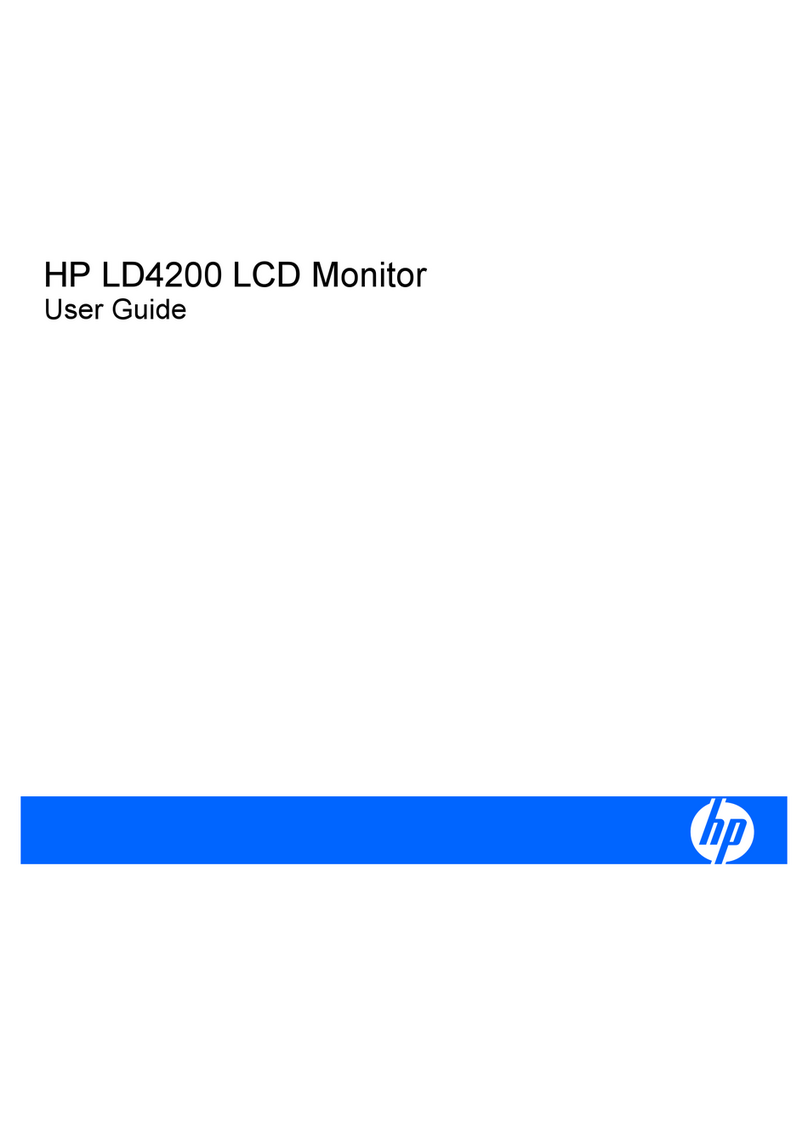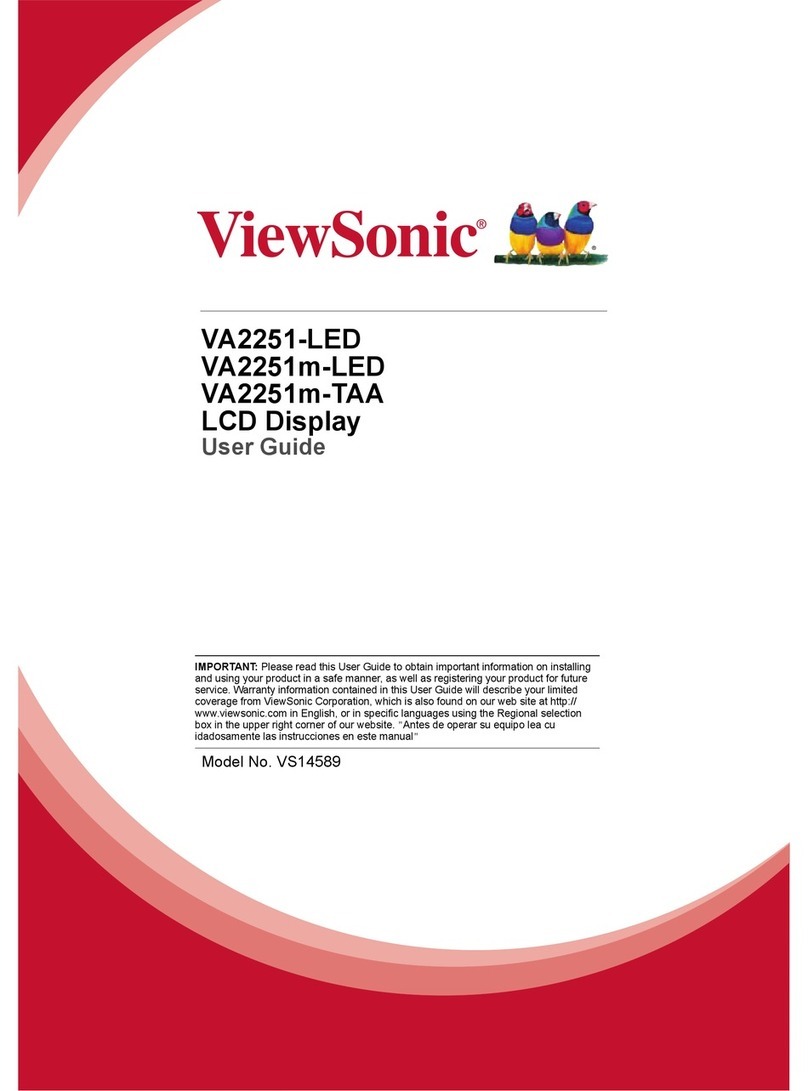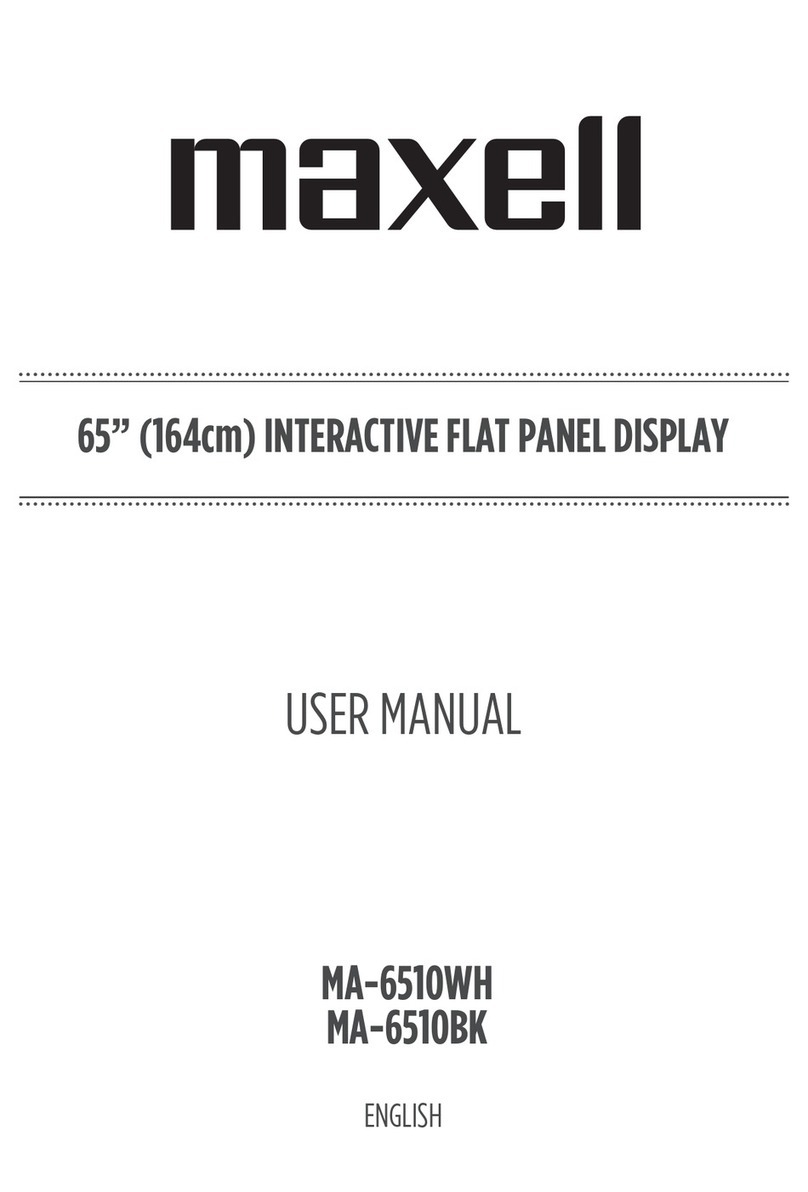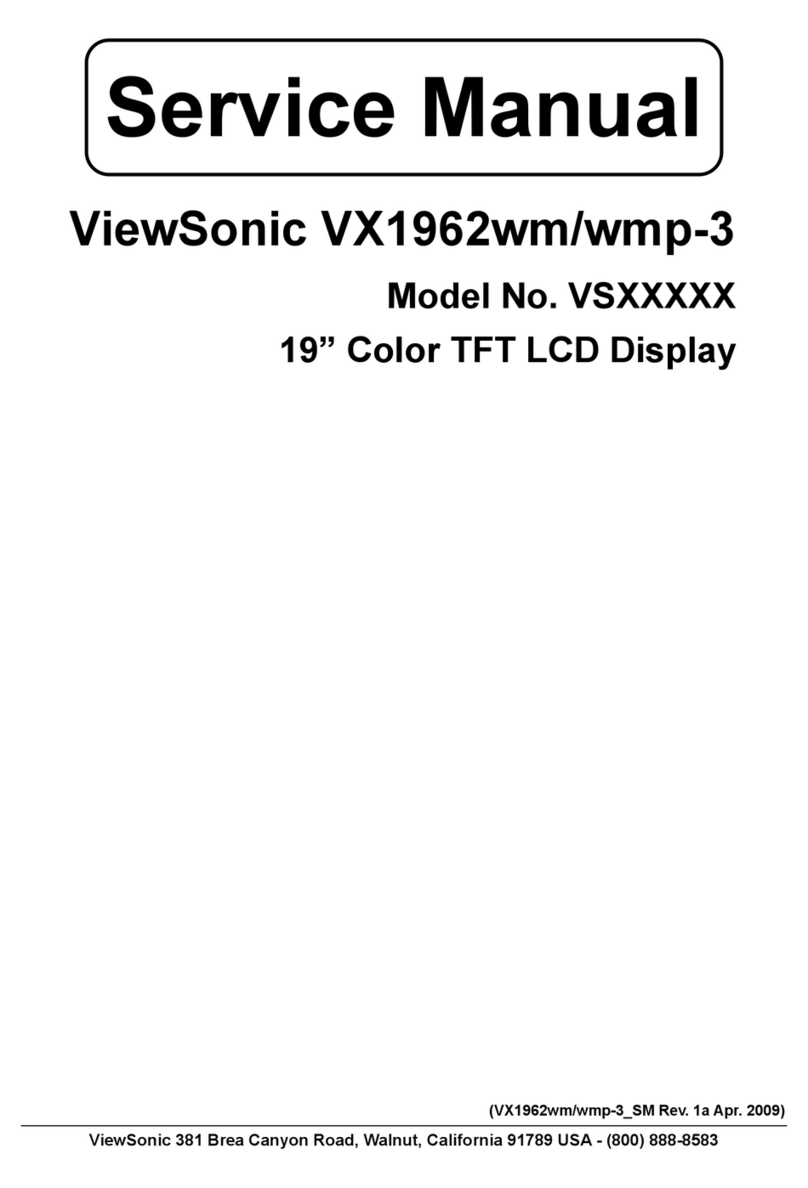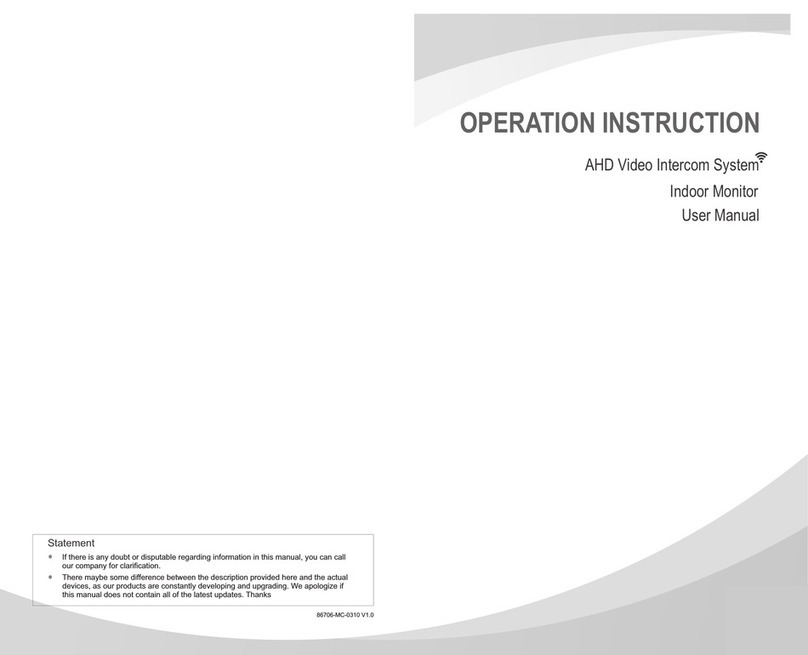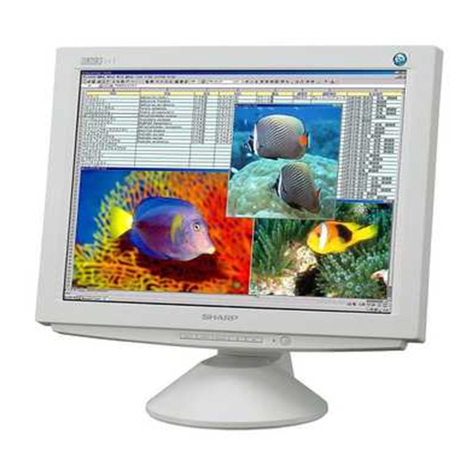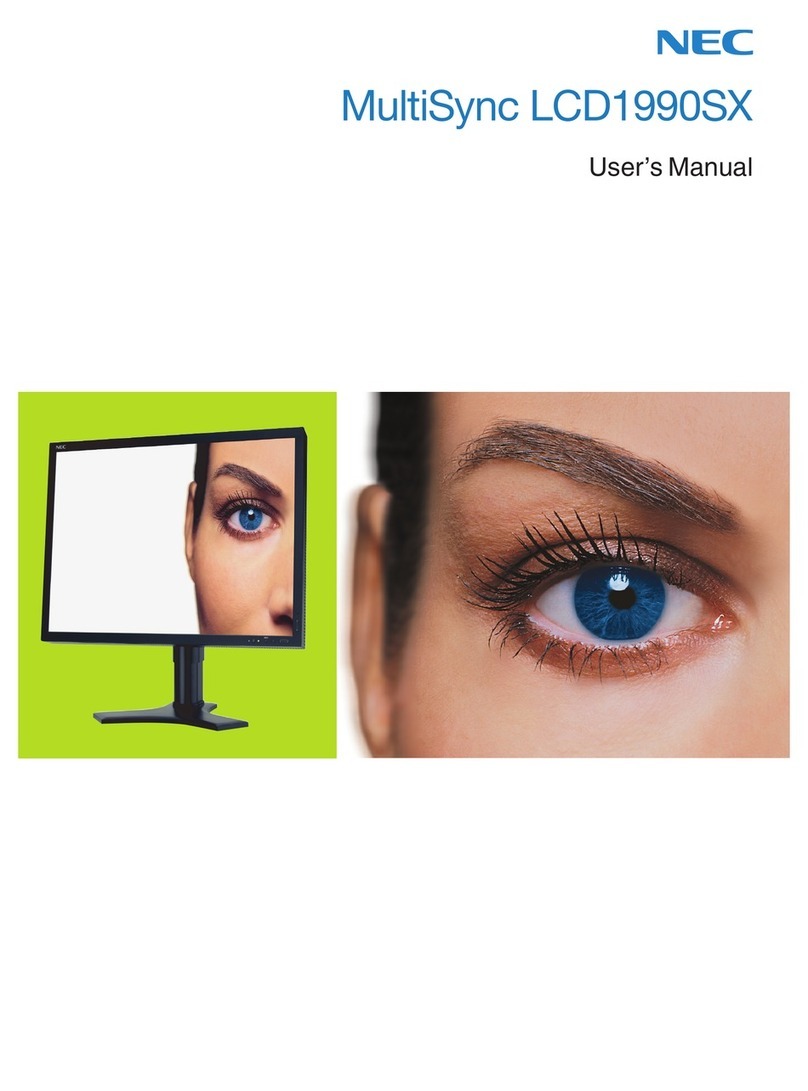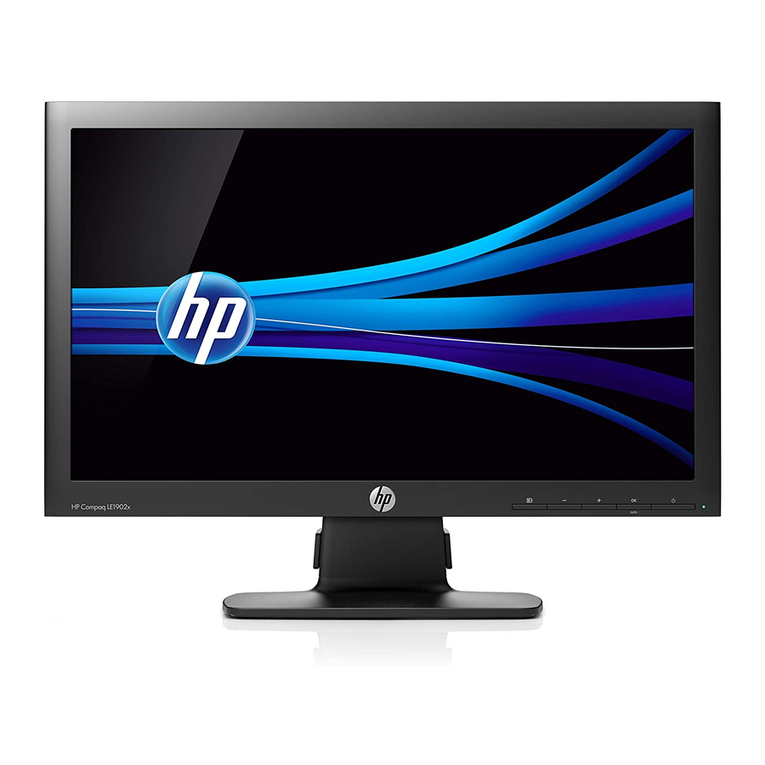NTI SPLITMUX-USB4K-4RT User manual

MAN240 Rev Date 11/23/18
SPLITMUX-4K-4RT(-R)
SPLITMUX-USB4K-4RT
Quad Screen 4K Multiviewer
Installation and Operation Manual
SPLITMUX®Series
SPLITMUX-4K-4RT
SPLITMUX-
U
SB4K-4RT

SPLITMUX Quad Screen 4K Multiviewer
i
TRADEMARK
SPLITMUX is a registered trademark of Network Technologies Inc in the U.S. and other countries.
COPYRIGHT
Copyright © 2014,2018 by Network Technologies Inc. All rights reserved. No part of this publication may be
reproduced, stored in a retrieval system, or transmitted, in any form or by any means, electronic, mechanical,
photocopying, recording, or otherwise, without the prior written consent of Network Technologies Inc, 1275 Danner
Drive, Aurora, Ohio 44202.
CHANGES
The material in this guide is for information only and is subject to change without notice. Network Technologies Inc
reserves the right to make changes in the product design without reservation and without notification to its users.
FIRMWARE VERSION
1.9
WARRANTY INFORMATION
The warranty period on this product (parts and labor) is two (2) years from the date of purchase. Please contact
Network Technologies Inc at (800) 742-8324 (800-RGB-TECH) or (330) 562-7070 or visit our website at
http://www.networktechinc.com for information regarding repairs and/or returns. A return authorization number is
required for all repairs/returns.

SPLITMUX Quad Screen 4K Multiviewer
ii
TABLE OF CONTENTS
Introduction......................................................................................................................................................................1
Supported Web Browsers ...............................................................................................................................................2
Materials..........................................................................................................................................................................2
Connectors and LEDs.....................................................................................................................................................3
Mounting..........................................................................................................................................................................4
Single-SPLITMUX mounting........................................................................................................................................5
Dual-SPLITMUX mounting ..........................................................................................................................................6
Reversible Mounting Assembly ................................................................................................................................7
Installation .......................................................................................................................................................................8
Terminal Connection for RS232 ................................................................................................................................10
Ethernet Connection for Remote User Control..........................................................................................................10
Power ON......................................................................................................................................................................11
Control Methods............................................................................................................................................................12
Front Panel Buttons...................................................................................................................................................12
Standard Mode .......................................................................................................................................................12
OSD Mode..............................................................................................................................................................14
Reset Resolution .................................................................................................................................................14
Device Discovery Tool...................................................................................................................................................15
How to Use the Device Discovery Tool.....................................................................................................................15
Use and Operation via Web Interface...........................................................................................................................16
Log In and Enter Password .......................................................................................................................................16
Administration-System............................................................................................................................................18
Administration-Network...........................................................................................................................................20
Administration- Input Settings.................................................................................................................................21
Administration- Output Settings..............................................................................................................................22
Audio Level and Gain..........................................................................................................................................23
Audio Mode Settings ...........................................................................................................................................23
Administration-Mode Settings.................................................................................................................................24
Administration- Custom Settings ............................................................................................................................26
Preset Layouts and Display Preview...................................................................................................................27
Alignment Tools...................................................................................................................................................27
Channel Settings.................................................................................................................................................28
Enable/Disable Channels....................................................................................................................................28
Save/Restore Layouts.........................................................................................................................................29
Cascade Settings....................................................................................................................................................30
Administration-User Config.....................................................................................................................................32
Administration- Firmware........................................................................................................................................33
Administration- System Information........................................................................................................................34
Logout........................................................................................................................................................................34
Support ......................................................................................................................................................................35
Reboot .......................................................................................................................................................................35
Command Line Interface...............................................................................................................................................36
RS232 Control...........................................................................................................................................................36
Baud Rate............................................................................................................................................................36
RS232 Command Protocol.....................................................................................................................................37
Telnet Control............................................................................................................................................................38
Using The Text Menu....................................................................................................................................................39

SPLITMUX Quad Screen 4K Multiviewer
iii
Text Menu Navigation..........................................................................................................................................39
Current Mode.............................................................................................................................................................40
System Configuration ................................................................................................................................................41
Network Configuration...............................................................................................................................................43
User Configuration.....................................................................................................................................................45
Input Configuration ....................................................................................................................................................47
Output Configuration..................................................................................................................................................48
Mode Configuration ...................................................................................................................................................50
Load/Save Layout......................................................................................................................................................53
System Information....................................................................................................................................................54
Using OSD.....................................................................................................................................................................55
Navigating the OSD menus....................................................................................................................................55
System Configuration ................................................................................................................................................56
Network Configuration...............................................................................................................................................57
Input Configuration ....................................................................................................................................................59
Output Configuration..................................................................................................................................................60
Mode Configuration ...................................................................................................................................................61
Load / Save Layout....................................................................................................................................................64
System Information....................................................................................................................................................65
Infrared Remote Control................................................................................................................................................66
Materials ....................................................................................................................................................................66
Buttons.......................................................................................................................................................................66
Operation...................................................................................................................................................................66
Changing Ports.......................................................................................................................................................67
Save and Recall......................................................................................................................................................67
Multiple Switch Control...........................................................................................................................................67
Technical Specifications For IRT-UNV......................................................................................................................67
Troubleshooting the IRT-UNV ...................................................................................................................................67
Example of Cascaded Configuration.............................................................................................................................68
Specifications ................................................................................................................................................................71
Troubleshooting.............................................................................................................................................................72
Index..............................................................................................................................................................................72
TABLE OF FIGURES
Figure 1- Attach ear brackets to front corners or rear corners...........................................................................................................4
Figure 2- Attach cable tray (if applicable)...........................................................................................................................................4
Figure 3- Attach rack ears..................................................................................................................................................................5
Figure 4- Assembled unit, ready to mount in rack..............................................................................................................................5
Figure 5- Attach ears and connector plate.........................................................................................................................................6
Figure 6- Attach cable tray connector................................................................................................................................................6
Figure 7- Assembly method for SPLITMUX with cables facing forward.............................................................................................7
Figure 8- Assembled SPLITMUX-4K-4RT-2R....................................................................................................................................7
Figure 9- Video Source/Display Connections-SPLITMUX-4K-4RT....................................................................................................8
Figure 10- Video Source\Display Connections- SPLITMUX-USB4K-4RT..........................................................................................9
Figure 11- RS232 Terminal Connection...........................................................................................................................................10
Figure 12- Ethernet connection........................................................................................................................................................10
Figure 13- Power Switch and LED...................................................................................................................................................11

SPLITMUX Quad Screen 4K Multiviewer
iv
Figure 14- Front Panel Button Functions.........................................................................................................................................14
Figure 15- Device Discovery Tool....................................................................................................................................................15
Figure 16- Login prompt to access web interface............................................................................................................................16
Figure 17- Initial page- Administrator...............................................................................................................................................17
Figure 18- Initial page- Non-Admin User..........................................................................................................................................17
Figure 19- System Configuration.....................................................................................................................................................18
Figure 20- Network Configuration....................................................................................................................................................20
Figure 21- Input Settings..................................................................................................................................................................21
Figure 22- Output Settings...............................................................................................................................................................22
Figure 23- Display with sound level indications ...............................................................................................................................23
Figure 24- Mode Settings.................................................................................................................................................................24
Figure 25- PIP Screen Mode Settings .............................................................................................................................................25
Figure 26- Custom Screen Mode Settings.......................................................................................................................................26
Figure 27- Pan and Crop Enabled...................................................................................................................................................27
Figure 28- Cascading SPLITMUXs..................................................................................................................................................30
Figure 29- Cascade Settings ...........................................................................................................................................................30
Figure 30- User Configuration..........................................................................................................................................................32
Figure 31- Firmware Update............................................................................................................................................................33
Figure 32- System Information page................................................................................................................................................34
Figure 33- Text Menu- Login screen................................................................................................................................................39
Figure 34- Text Menu-Main Menu....................................................................................................................................................40
Figure 35- Text Menu-Current Mode Selection................................................................................................................................40
Figure 36- Text Menu- System Configuration..................................................................................................................................41
Figure 37- Text Menu- Unit Settings................................................................................................................................................41
Figure 38- Text Menu- Serial Port Settings......................................................................................................................................42
Figure 39- Text Menu- OSD Screen Settings ..................................................................................................................................42
Figure 40- Text Menu- Restore Default Settings..............................................................................................................................43
Figure 41- Text Menu- Network Configuration.................................................................................................................................43
Figure 42-Text Menu- IPv4 Network Settings..................................................................................................................................44
Figure 43- Text Menu-Server Settings.............................................................................................................................................45
Figure 44- Text Menu- Users List ....................................................................................................................................................45
Figure 45- Text Menu- Account Settings..........................................................................................................................................46
Figure 46- Text Menu- User Account Settings.................................................................................................................................46
Figure 47- Text Menu- Input Configuration......................................................................................................................................47
Figure 48- Text Menu- Output Configuration ...................................................................................................................................48
Figure 49- Text Menu- Audio Output Configuration.........................................................................................................................49
Figure 50- Text Menu- Mode Settings Menu....................................................................................................................................50
Figure 51- Text Menu- Default Mode Configuration.........................................................................................................................50
Figure 52- Text Menu- Full Screen Mode Settings ..........................................................................................................................51
Figure 53- Text Menu- Quad Mode Settings....................................................................................................................................51
Figure 54- Text Menu- PIP Mode Settings.......................................................................................................................................52
Figure 55- Text Menu- Custom Mode Settings................................................................................................................................53
Figure 56- Text Menu- Load/Save Layout........................................................................................................................................53
Figure 57- Text Menu- System Information......................................................................................................................................54
Figure 58- Front Panel Button OSD Functions ................................................................................................................................55
Figure 59- The OSD Menu...............................................................................................................................................................55
Figure 60- OSD System Configuration.............................................................................................................................................56
Figure 61- OSD Network Configuration ...........................................................................................................................................57
Figure 62- OSD IP Settings .............................................................................................................................................................58
Figure 63- OSD Server Settings......................................................................................................................................................58
Figure 64- OSD Input Configuration ................................................................................................................................................59
Figure 65- OSD Input Settings.........................................................................................................................................................59
Figure 66- OSD Output Settings......................................................................................................................................................60
Figure 67- OSD Mode Settings........................................................................................................................................................61

SPLITMUX Quad Screen 4K Multiviewer
v
Figure 68- Default, Full Screen and Quad Screen Settings.............................................................................................................62
Figure 69- PIP Screen Mode settings..............................................................................................................................................63
Figure 70- OSD- Custom Screen Mode Settings.............................................................................................................................64
Figure 71- OSD- Load/Save Layout functions .................................................................................................................................64
Figure 72- Save or Load a Custom Layout......................................................................................................................................65
Figure 73- OSD- System Information Page .....................................................................................................................................65
Figure 74- View of cascaded configuration from Master..................................................................................................................68
Figure 75- View of cascaded configuration from Slave at IP 192.168.3.173....................................................................................69
Figure 76- View of cascade configuration from Slave at IP 192.168.3.125......................................................................................69
Figure 77- View of custom configuration of Slave at IP 192.168.3.183............................................................................................70
Figure 78- Current output mode selection........................................................................................................................................70

SPLITMUX Quad Screen 4K Multiviewer
1
INTRODUCTION
The SPLITMUX® HD Quad Screen Multiviewer allows you to simultaneously display 4k Ultra High Definition video from four
different computers or video sources on a single monitor providing resolutions up to 4096 x 2160.
Features:
Quad, Picture in Picture, Full Screen, and Custom display modes.
Independent video in to video out resolution.
Supports HDTV input resolutions
oUp to 1080p/36-bit, 2048x1080 @ 60Hz or 1920x1200 @ 60Hz HDMI 1.3a inputs (2.25Gbps bandwidth).
Supports HDTV output resolutions
oUp to UHD(2160p), 4096x2160 @ 60Hz HDMI 2.0 output (4k/UHD real-time video).
Connect digital video sources to the splitter and display images on a digital monitor.
Output resolution and frame rate independent of input.
Full-screen, quad-screen, picture-in-picture, and custom modes with configurable window transparency.
oFull-screen and quad-screen display at up to 4k resolution
oPicture-in-picture and custom modes display at maximum 1080p resolution
On-screen display.
Front panel pushbutton, two USB hot keyboard/mouse ports (for navigating OSD, moving/resizing windows, naming
inputs, etc.), Ethernet (web server with GUI and Telnet), RS-232, and IR control.
Infinite number of levels of video cascading with web server GUI support .
USB KVM version:
oThe two attached USB device ports (for hot keyboard/mouse) double as inputs for human interface device
emulation.
o2-port USB 2.0 high-speed transparent switch.
HDMI features supported:
oInputs: 24-, 30-, and 36-bit xvYCC, sRGB, and YCbCr.
oOutputs: 24- and 30-bit sRGB.
oFour-channel mixing stereo with 16-, 20-, or 24-bit uncompressed PCM audio.
oInput Bandwidth up to 165 MHz (2.25 Gbps); Output bandwidth up to 594Mhz (5.94Gbps).
Any DVI source or display can be connected by using the DVI-HD-xx-MM cable (not included).
oUse DVIA-HD-CNVTR-LC or DVI-HD-CNVTR DVI + Audio to HDMI Converters to pass and independently
switch audio signals to the multiviewer.
HDCP compliant - V1.2 (on Inputs) and V1.4\2.2 (on Outputs)
On-screen display
Fluid, real-time video performance with up to 60 frames per second (fps) in all four quadrants
HDMI-embedded audio switching (four-channel stereo, non-mixing or one-channel stereo, mixing).
oSwitch audio independently of video from HDMI sources
Control the multiviewer through the front panel buttons, on screen display (OSD), RS232 serial port, infrared remote
control or Ethernet.

SPLITMUX Quad Screen 4K Multiviewer
2
Backup and restore multiviewer configuration.
Supported output resolutions can be selected or set to auto detect.
Available options: desktop unit, 1RU rackmount unit, dual side-by-side rackmount units in 1RU.
oRackmount units can be mounted so that the front panel buttons are facing the front or back of the rack.
oRackmount units include cable management shelf.
oAll units can be purchased with a medical grade power supply for healthcare industries.
SUPPORTED WEB BROWSERS
Most modern web browsers should be supported. The following browsers have been tested:
Microsoft Internet Explorer 8.0 or higher
Mozilla FireFox 30.0 or higher
Opera 12.02 or higher
Google Chrome 9.0.5 or higher
Safari 5.0 or higher for MAC and PC
MATERIALS
Materials supplied with SPLITMUX-4K-4RT:
NTI SPLITMUX-4K-4RT Multiviewer
1- 120VAC or 240VAC at 50 or 60Hz-5VDC/6A AC Adapter (PS4091)
CT6182 DB9 Female-to-RJ45 Female adapter
CB7094 5 foot CAT5E-SF32-5-BLACK patch cable
CT7003 IR Remote Control with two (2) AAA batteries (PS0154)
Materials supplied with SPLITMUX-USB4K-4RT:
NTI SPLITMUX-USB4K-4RT Multiviewer
1- 120VAC or 240VAC at 50 or 60Hz-9VDC/8A AC Adapter (PS4212)
CT6182 DB9 Female-to-RJ45 Female adapter
CB7094 5 foot CAT5E-SF32-5-BLACK patch cable
CT7003 IR Remote Control with two (2) AAA batteries (PS0154)
Additional Materials Included with SPLITMUX-4K-4RT-R (same as SPLITMUX-4K-4RT plus the following):
2- MP4829 Ear Brackets
2- MP4826 Long Rack Ears
1- MP4825 Cable Tray
12- HW5133 #6-32x1/4” Flat head Screws
Materials Included with SPLITMUX-4K-4RT-2R (same as SPLITMUX-4K-4RT plus the following):
6- MP4829 Ear Brackets
2- MP4827 Short Rack Ears
1- MP4830 Cable Tray Connector
2- MP4828 Connector Plate
2- MP4825 Cable Tray
28- HW5133 #6-32x1/4” Flat head Screws
Additional materials may need to be ordered;
CAT5/5e/6 unshielded twisted-pair cable(s) terminated with RJ45 connectors wired straight thru- pin 1 to pin 1, etc. for Ethernet
connection
Contact your nearest NTI distributor or NTI directly for all of your cable needs at 800-RGB-TECH (800-742-8324) in US & Canada
or 330-562-7070 (Worldwide) or at our website at http://www.networktechinc.com and we will be happy to be of assistance.

SPLITMUX Quad Screen 4K Multiviewer
3
CONNECTORS AND LEDS
# LABEL CONNECTOR/LED DESCRIPTION
1-4 HDMI Input Selection (Standard Mode)
1 +, -, TAB, ENTER Pushbuttons OSD Menu Navigation (OSD Mode)
SCREEN-
FULL,QUAD,PIP,MODE
(Display Modes)
For selecting the display mode for image placement on the user’s
monitor
2
Directional Arrows
Pushbuttons
Used for OSD Menu Navigation
Also used to toggle the OSD Menu ON/OFF and returning the
SPLITMUX to the default display resolution
3 IR IN IR Sensor Input sensor to receive IR signals from remote control
4 Green/Red LED To indicate when the SPLITMUX is powered ON (Green) or in
Standby (Red)
5
PWR/STBY
Rocker switch For switching the SPLITMUX between ON (I) and Standby (O)
6 5VDC Power Jack For connection of power supply
“9V8A” for SPLITMUX-USB4K-4RT (2.5x5.5mm)
“5V3A” for SPLITMUX-4K-4RT (2.1x5.5mm)
7 HDMI IN 1-4 HDMI female connector For connection of HDMI video sources
8 HDMI OUT HDMI female connector For connection of cable to HDMI Monitor
9 RS232 (DCE) RJ45 female connector For RS232 serial connection of a terminal to control the system
10 ETHERNET RJ45 female connector For connection to an Ethernet for remote multi-user control
Yellow LED- indicates 100Base-T activity when illuminated,
10Base-T activity when dark
Green LED – illuminated when Ethernet link is present,
strobing indicates activity on the Ethernet port
11 USB USB Type A Female For connecting USB devices (mouse and keyboard) to control
connected CPUs (SPLITMUX-USB4K-4RT only)
12 KYBD/MOUSE USB Type A Female For connecting keyboard and mouse to control SPLITMUX from
OSD menus
13 CPU IN 1-4 USB Type B Female For connecting USB device cables from connected PCs

SPLITMUX Quad Screen 4K Multiviewer
4
MOUNTING
The SPLITMUX-4K-4RT can be purchased in a 1RU case with parts and hardware for mounting in a rack as a single unit
(SPLITMUX-4K-4RT-R) or as a dual unit (SPLITMUX-4K-4RT-2R). (SPLITMUX-4K-4RT is for desktop mount only. The
SPLITMUX-USB4K-4RT comes standard as a rackmount unit.) Follow the instructions below for assembly and installation.
Whether the SPLITMUX will be mounted as a single or a double, brackets will be attached to the case to enable mounting ears or
a connector plate to be attached.
1. Attach the ear brackets to the SPLITMUX. The holes in the brackets should line up with pre-threaded holes in the sides
of the SPLITMUX. Tighten the screws securely.
Note: If the ear brackets are applied to the rear, the cable management tray cannot be used.
Figure 1- Attach ear brackets to front corners or rear corners.
2. If the ear brackets have been applied such that the front will face out, assemble the cable tray to the holes in the rear of the
SPLITMUX as shown below.
Figure 2- Attach cable tray (if applicable)
FYI: The same hole pattern is
provided at the front and rear of
the SPLITMUX, enabling the
SPLITMUX to be mounted with
the front facing out or rear
facing out.

SPLITMUX Quad Screen 4K Multiviewer
5
Single-SPLITMUX mounting
1. To mount a single SPLITMUX in a rack (SPLITMUX-4K-4RT-R), attach the rack mounting ears to the ear brackets using the
#6-32 x 1/4” screws provided. Tighten all screws securely.
Figure 3- Attach rack ears
Figure 4- Assembled unit, ready to mount in rack
2. Install 4 cage nuts (provided) to the rack in locations that line up with the holes in the mounting ears on the SPLITMUX.
3. Secure the SPLITMUX to the rack using the four #10-32x3/4” screws provided. Be sure to tighten all mounting screws
securely.
Note: Do not block power supply vents in the SPLITMUX case. Be sure to enable adequate airflow in front of and
behind the SPLITMUX.

SPLITMUX Quad Screen 4K Multiviewer
6
Dual-SPLITMUX mounting
1. To mount a dual SPLITMUX in a rack (SPLITMUX-4K-4RT-2R), attach the rack ears to the far left side of the left SPLITMUX
and right side of the right SPLITMUX using the #6-32 x 1/4” screws provided. Then install a connector plate to join the two
SPLITMUXs in the front.
Figure 5- Attach ears and connector plate
2. Install a cable tray connector between the cable trays using 4 more #6-32x1/4” screws.
Figure 6- Attach cable tray connector

SPLITMUX Quad Screen 4K Multiviewer
7
Reversible Mounting Assembly
If the SPLITMUXs will have the cable connections facing the front of the rack, then two more ear brackets will need to be installed
to the rear corners of the cases that will be closest to each other. (Install these before attaching the connector plate to the front.)
Once the ear brackets are applied, the ears and connector plates can be attached.
Figure 7- Assembly method for SPLITMUX with cables facing forward
Figure 8- Assembled SPLITMUX-4K-4RT-2R
3. Tighten all screws securely. The SPLITMUX is ready for mounting.
4. Install 4 cage nuts (provided) to the rack in locations that line up with the holes in the mounting ears on the SPLITMUX
assembly.
5. Secure the SPLITMUX to the rack using the four #10-32x3/4” screws provided. Be sure to tighten all mounting screws
securely.
Note: Do not block vents in the SPLITMUX case. Be sure to enable adequate airflow in front of and behind the
SPLITMUX.

SPLITMUX Quad Screen 4K Multiviewer
8
INSTALLATION
1. Connect each of the HDMI or DVI video sources to the ports on the SPLITMUX marked “HDMI IN x” (x = 1-4).
2. Connect the display to the port marked “HDMI OUT”.
3. Connect the power supply to the power jack and plug it in. In approximately 20 seconds, the LED on the SPLITMUX will
illuminate red (standby).
4. Press the switch on the front to power the SPLITMUX ON. Within 20 more seconds the LED will change from red to green
(ON) and the SPLITMUX will be ready to use.
5. For keyboard and/or mouse control of the OSD menu of the SPLITMUX, connect a USB keyboard and/or mouse to the USB
type A ports labeled “KYBD/MOUSE” on the SPLITMUX. On models supporting transparent USB device connection
(SPLITMUX-USB4K-4RT), the keyboard and mouse connected to these ports will also control the keyboard and mouse functions
on any connected PC. (See Figure 10)
Figure 9- Video Source/Display Connections-SPLITMUX-4K-4RT
Note: If the connected display does not
support an HDMI input (typically it will
have at least one HDMI input port), the
display will not be compatible.

SPLITMUX Quad Screen 4K Multiviewer
9
6. For SPLITMUX units supporting USB CPUs (SPLITMUX-USB4K-4RT), a USB2-AB-xM cable (where x = 0.5 meter, 3,6,10 or
15 feet)(sold separately) can be connected between a USB port on the CPU and a “CPU IN x) port corresponding with the
“HDMI IN x” port the video from the CPU is connected to.
7. Connect any desired USB devices to the ports labeled .
With the connections made in steps 6 and 7, the keyboard and mouse connected to the “KYBD/MOUSE” ports and any USB
device connected to the ports labeled will be active for the connected CPU when the video from that CPU is selected in
the SPLITMUX.
Figure 10- Video Source\Display Connections- SPLITMUX-USB4K-4RT

SPLITMUX Quad Screen 4K Multiviewer
10
Terminal Connection for RS232
If control via serial connection is going to be used, serial control can be achieved by connecting a control terminal to the “RS232”
port .
To use the “RS232” port, connect one end of a CAT5 patch cable (supplied) to the port labeled “RS232” on the rear of the
SPLITMUX. Plug the other end of the CAT5 cable into an RJ45-to-DB9F adapter (supplied), and connect the adapter to the
RS232 port on the control terminal.
Figure 11- RS232 Terminal Connection
Ethernet Connection for Remote User Control
To make a remote connection, over the Ethernet, from anywhere on the local area network, connect a CAT5/5e/6 Ethernet
cable with RJ45 male connectors on the ends, wired straight through (pin 1 to pin 1, pin 2 to pin 2, etc.). Up to 8 users can
connect to the SPLITMUX using the Ethernet at a time.
Note: A direct connection from a computer’s Ethernet port to the SPLITMUX “ETHERNET” port may also be made using
the same cable.
Figure 12- Ethernet connection

SPLITMUX Quad Screen 4K Multiviewer
11
POWER ON
When you plug in the AC adapter between the SPLITMUX and your power supply, with the power switch OFF (switch towards
“O”), the LED on the SPLITMUX will illuminate red after approximately 20 seconds. To use the SPLITMUX, press the power
switch to ON (switch towards “I”). After 20 more seconds the LED will change from red (standby) to green (ON). The
SPLITMUX is now powered up and ready to use.
When powering the SPLITMUX OFF, always press the power switch to OFF (switch towards “O”). Then wait 5 seconds or so
until the green LED changes to red. Once it is red, you can then safely unplug the SPLITMUX from the power source.
WARNING: If you unplug the power source before powering OFF the SPLITMUX at the power switch, you may lose saved
data and configuration information.
Figure 13- Power Switch and LED

SPLITMUX Quad Screen 4K Multiviewer
12
CONTROL METHODS
The SPLITMUX can be controlled using any of six methods;
Standard Mode using the front panel buttons
OSD Mode using the front panel buttons and/or keyboard and mouse,
Using the Command Line Interface either through RS232 or remote connection
Using a Text Menu either through RS232 or remote connection
Using a hand-held IR Remote Control
Remotely through the Web Interface using an Ethernet connection.
Front Panel Buttons
The buttons on the front panel have two separate sets of functions, depending upon what mode the SPLITMUX is in; Standard
Mode or OSD Mode.
Standard Mode
In Standard Mode, the left 4 buttons control which video source is viewed as the active image on the monitor, whether the
SPLITMUX is in Full or PiP mode. The right 4 buttons determine which mode format the monitor will display the video signals in.
When FULL is pressed, the input selected using buttons 1 through 4 (or “active” image) will be the only image on
the display. The audio from the selected input will also be heard provided the audio input is set to "Automatic".(See
pages 23 or 60)
When QUAD is pressed, images from all 4 inputs will be displayed equally on the monitor. The audio from the last
active image will continue to be heard.
When PIP is pressed, the active image will occupy the entire screen and the images from the remaining inputs will
be displayed in lower resolution on the right side of the screen.
When CUSTOM is pressed, the images will be displayed in whatever way you have the SPLITMUX configured to
present them. Each input can be sized and positioned on the screen as desired.
In FULL screen mode, only the active video source will be displayed. The image will be viewed at full size
and up to 4K resolution.

SPLITMUX Quad Screen 4K Multiviewer
13
In QUAD screen mode, all four video sources share the screen
equally. Each video source is displayed completely. The
maximum output resolution is 4K in Quad mode.
In PIP mode (right) , either 2, 3 or all 4 video sources can be
displayed, with the active source being displayed in its
entirety on the full screen and the remaining selected
images at a reduced resolution for simultaneous viewing.
The position of the reduced images can be configured for
preferred viewing. The maximum output resolution is 1080p
in PIP mode.
In CUSTOM mode (below) the 4 video sources can be
placed where ever you want, at what ever size you want.
The amount of each source that is viewed is determined by
your configuration. The maximum output resolution
is 1080p in Custom mode.

SPLITMUX Quad Screen 4K Multiviewer
14
OSD Mode
In OSD Mode, the buttons are used to navigate and control the SPLITMUX using the OSD menu.
To bring up the OSD menu, press the FULL and QUAD buttons at the same.
To exit the OSD menu, press the FULL and QUAD buttons at the same time again, or press <Esc> on the keyboard..
Figure 14- Front Panel Button Functions
Reset Resolution
In the event an incompatible resolution setting is applied to the SPLITMUX, to quickly restore the images of video sources to the
SPLITMUX, press the PIP and CUSTOM buttons at the same time. This will reset the output to the default resolution of
640x480 @60Hz.
This manual suits for next models
7
Table of contents
Other NTI Monitor manuals
